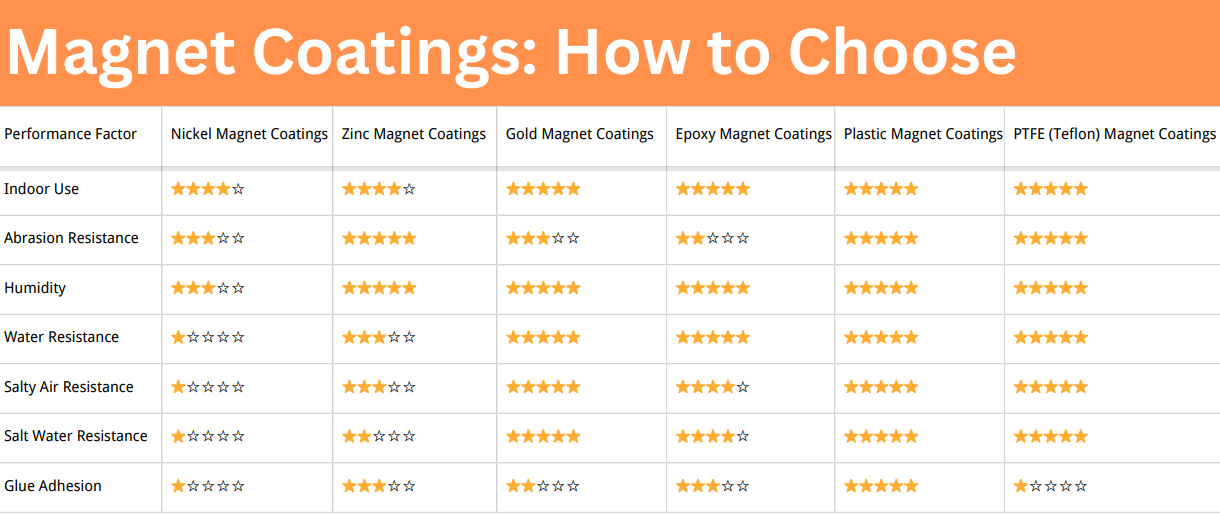What Are PTFE-Coated Magnets?
Introduction
Magnets are extensively used in a range of fields. You can find them in headphones, cellphones, generators, and MRI (magnetic resonance imagers). These devices produce strong magnetic fields under different conditions. Sometimes extra coatings are needed to protect the magnets from harsh environments and reduce maintenance costs. This article is going to introduce an effective coating--the PTFE magnet coating. Hope that you can have a deep understanding of such helpful magnet coating.

Figure 1: Coated Magnets
Importance of Magnet Coatings
Magnets are covered with different kinds of coatings like plastic, rubbers, and metals, which bring about the following benefits.
- Magnet coatings are used to improve corrosion resistance.
If your magnets have to work in a highly corrosive environment, adding a coating is quite necessary. For example, magnet coatings can protect the magnetic field from damage in a humid environment.
- Magnets use coatings for other enhancements.
A majority of magnets are hard yet brittle, so they need coatings to improve their physical strength. Also, coated magnets are easier to clean because they have a smoother surface.
- A coating is a cost-effective method in the long term.
If you choose suitable coatings for your magnets, you can save lots of costs since you do not need to replace disabled magnets frequently. Related reading 1: Why Should You Choose Rubber-Coated Magnets?
What Is PTFE Coating?
PTFE (Polytetrafluoroethylene or Teflon) is an artificial polymer composed of carbon and fluorine. PTFE (Polytetrafluoroethylene) is a strong material, while Teflon is the most famous brand name of PTFE. This tough material was discovered accidentally in 1938, and it has been popular in the market for about 7 decades ever since. PTFE-coated magnets stand out for their thermal, physical, and chemical properties.
- PTFE coatings could stand an operating temperature as high as 260°C/500°F.
- These coatings are famous for their great resistance to abrasion and corrosion.
- PTFE-coated magnets have strong carbon-fluorine bonds, so they create little friction.
Such material is applied to numerous sectors. You can not only find this material in cookware but also in optical devices, cables, pipes, valves, and automotive components.
Other Coating Materials
Apart from PTFE, metals, rubbers, and plastics are ideal choices to make magnet coatings for protection and enhancement.
- PTFE has several alternatives.
Fluorinated Ethylene Propylene (FEP), Perfluoroalkoxy (PFA), and Ethylene Tetrafluoroethylene (ETFE) are similar to PTFE. FEP offers similar non-stick and non-reactive properties. PFA is known for high-use temperatures and toughness. ETFE has a lower density than PTFE, and it is used in aerospace insulation.
- There are several metal coatings available.
Nickel is one of the most popular materials for coatings, and it is used in sensors, engines, and generators. Gold-coated magnets could be applied to the medical field, and their maximum operating temperature is 473 K.
- Epoxy coatings are very useful.
Epoxy could withstand weak acids, alkaline solutions, and moist environments. They are employed to make components for tidal power plants and offshore wind turbines. Related reading 2: Something You Should Know About Neodymium Magnets Coatings
Case Study: PTFE-Coated Magnets Used in Corrosive Environment
- Background: Our customer Imerys is a large company producing graphite and carbon. When they prepare powder for graphite synthesis, the binder devices were immersed in a highly corrosive environment, and the magnets inside might lose their magnetism.
- Trials: Therefore, they used epoxy coatings and plastic wrapping around the magnet to maintain the magnet’s performance. All those methods didn’t work, so they asked for our help.
- Solution: Stanford Magnets is a leading magnet supplier. We recommended the PTFE material, because epoxy is not strong enough to resist chemical corrosion, yet Teflon is highly resistant to most corrosive chemicals and has great thermal stability at high temperatures.
As a result, Stanford Magnets successfully solved this problem using PTFE coatings. Stanford Magnets have rich experience in the manufacturing, sales, and maintenance of magnets. We also give professional advice and services. You can check our website for more information. Related reading 3: Teflon (PTFE) Coated Magnets Used in Highly Corrosive Environment
Conclusion
The non-stick, non-reactive PTFE coatings are used to protect the magnets from breaking and maintain their magnetic forces. Stanford Magnets provides PTFE-coated magnets with Japan High Polymer Center Certificate and Dupont Certificate. Send us an inquiry if you are interested.














